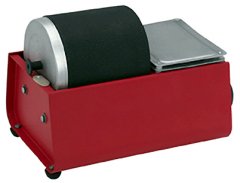
Black Powder
Retrieved: 08/23/2016
Black Powder
It takes longer to talk about this than it does to do it.
SUPER FAST BP IS NOT A SOLUTION FOR MOST PYRO NEEDS - READ THE NEXT TWO PARAGRAPHS BEFORE YOU START THE BP ODYSSEY
When I first created BP, I had poor results. I suspect many of us did. We searched for better methods and we incrementally started to improve things. With me, it became fascinating when I found that three simple ingredients housed a world of possibilities.
However, in the quest to find the hottest powders and processes, it was easy to forget that the hottest BP was probably not the best BP for most jobs. Drivers, rocket motors, primes, fusing, and even lift powder can be adversely affected if the BP is too reactive. When we start talking about BP being twice as hot as commercial quality 2fg, then using it means we have to 'tone it down' by adding more charcoal or inhibitors such as baking soda or oil, or making it more granular so it doesn't slam our shells to pieces. BP made with Skylighter charcoal is not very fast. But it doesn't have to be. So, even if we use Skylighter charcoal or lump-wood charcoal (similar to Skylighter), fertilizer grade KNO3, and dissolvable garden sulfur in our BP, we will still have a useful product for the majority of our pyro devices. See Cheap Tricks #1 on this page and also the experiment using Agricultural Grade Chemicals.
Black powder - the basis for many things in the pyro hobby - can be made in many, many different ways. In addition, the different common names for black powder are sometimes confusing and are certainly varied. Black powder, gun powder, lift powder, grain powder, and meal powder are basically all the same material. As black powder is created, it goes through stages which also have names. You will hear about green meal, or green powder, which is the unprocessed mix of BP ingredients, pulverone, riced powder, corning dust, meal, and probably dozens of other terms - too many to explain for the purposes of this short section.
This section assumes we are using pulverone - Europeans and some Yanks spell it polverone. Pulverone is ball milled BP that has been slightly moistened so that it just clings together and pressed through a fine, non-sparking, screen - an aluminum window screen will work. The resultant granules are dried and used for a number of different tasks. While you can leave the BP in the ball milled state for packing in tubes - it will be a fine dust and very hard to work with. Making pulverone out of it decreases the dust problem and actually makes the hotter powders useful as lift powders because of the air spaces between the grains. Pulverone is a good way to get started.
If one wants to make high grade BP that has a tough grain, then the BP must be pressed then granulated. Granulated BP that has been pressed is also known as corned BP. Corning is not terribly difficult for the hobbyist but it does add to the workload and expense of making BP. See a brief explanation in the 'Process' section below.
For every pyro hobbyist, you will find a different set of preferences for making this basic ingredient. Sometimes hobbyists will be very stubborn about their methods and swear they are the only way to make good BP. Don't be fooled, there are many ways to create it. The following are a couple of ways to do the job:
Precipitation or CIA Method works but only works good if you ball mill it afterwards (but it makes really good powder then!). I don't use the CIA method because it is messy and more dangerous because of the boiling potassium nitrate solution and alcohol quenching. There are differing opinions about the dangers of CIA versus ball milling and in the end, it is what one is comfortable doing - and I'm not very comfortable boiling this stuff. Here is a link to a summary of how to do the CIA method: cia.html
Ball mills are required to make good consistent powder that realizes the potential of the ingredients. However, you don't need a ball mill to make acceptable pyro powders for many applications. See Cheap Tricks below for a perfectly acceptable alternative.
Safety issues. The biggest danger from ball mills is the danger of explosion. Never ball mill BP indoors and always use non-sparking milling media. I use50 caliber lead balls but I also have used brass chunks cut from 1/2 to 5/8 bar. Don't use marbles or steel balls of any sort. I personally think ball mills are safe if used to mill BP (not other propellants!); however, there are lots of war stories about ball mills exploding. Until there is better documentation, it is advisable to play it very safe and never ball mill indoors or around people or buildings. It is uniformly accepted in our Pyro community that milling outdoors is the only acceptable practice - I always follow this safe practice.
If you haven't gotten one yet, then get a ball mill or make one. Look up ball mills, or rock tumblers, on the web - get a cheap one from Harborfreight.com - don't buy one on eBay or from other dealers until you do a price compare - there is a small ball mill from China that sells from $19 (Harbor Freight on sale) to about $80 at other sites (same mill!).

Example of Chinese rock tumbler sold by several firms using different brand names and sometimes with different colors
The cheap Chinese ball mills (above) are always breaking their drive belts - one spare is provided but you will likely need another within the year. I broke two in as many days while doing the charcoal tests (charcoal_tests.html). The belt looks like a vacuum cleaner belt but it is not as fat (and a vacuum cleaner belt won't fit). I found replacements at a hardware store where they sell large O rings. The belt is about 4" O.D. (not quite) and they make an O ring that is just about right. The lighter you load the mill - which generally means the lesser amount of lead milling media you put in - the longer the belt will last. However, the trade off is that the mill becomes inefficient when too lightweight. I run them at about 2.5 to 2.8 pounds but that is a bit heavy and the belts suffer.
The cheaper mills (even Thumler's Tumblers) won't hold enough lead balls to make efficient use of the entire mill - but will hold enough to do the job. A good hobby pyro mill will probably make BP in about 6 hours. These mills require about 24 to 40 hours. Even with that, the mill won't get the full benefit from some charcoals. A larger 'Sponenburgh' type mill is necessary to get optimum results (see charcoal_tests.html). You don't need the bigger mill until you've decided what you want to spend. The smaller mill will work if you use reactive charcoals.
Be careful when you first get your mill and don't overload it. I have a mill like the one above that claims to be a 3 pound mill but the most powder I can put in it is about 200 grams - the rest of the weight - up to about 2.5 pounds - is lead balls. Filling the mill 1/3 full of lead balls would burn out the motor yet that is exactly what many directions on the net tell you to do. Don't exceed the max load of the mill - even if the milling won't be as efficient. Ball mill black powder outdoors.

I have made my own mill - but I didn't make it until I understood about mills. I learned about them by buying a cheap one and working with it for a while. If you decide to make your own, think about selecting a continuous duty ~1750 rpm motor as the drive (rpm specifications on motors may vary depending on your local AC mains). A robbed motor from a shop tool may not have the duty cycle for running a ball mill - which may run for 48 hours or more at a time. You can find ideas on how to build a ball mill at many sites on the web so look a few up - don't take the first example you see but examine a few to understand the concept. You can start by looking at misc.html#ballmill. Without a doubt, a mill like the one in the picture above, with a 6" jar and about 30 pounds of milling media will produce much better BP at a much quicker pace than the small rock tumblers.

Black willow logs being split up for charcoal
Charcoal is the big variable when making black powder for any of the driver fuels such as RP or RPH. It also affects how a star will burn and look. Different charcoals will vary black powder lift capability by an order of magnitude or more. See the video that compares charcoal briquette black powder to pine charcoal blackpowder. In that video, 2 grams of pulverone were used for each test. The charcoal briquette BP sent the test shell to 3 feet - the pine charcoal BP sent the test shell to more than 200 feet. See the data on more tests at charcoal_tests.html. To read more about this (and maybe buy a book!) read "Black Powder Testing and Optimization" - American Fireworks News ( www.fireworksnews.com ) has a link to a single chapter at: "Black Powder Testing and Optimization" by Ian Von Malttiz.
To standardize on something, I've picked the airfloat charcoal from Skylighter as the standard for charcoal in all the compositions.html formulas unless specifically stated otherwise. The commercial airfloat does not make the hottest BP (far from it - in my own tests using hobby rock tumblers for mills, Skylighter charcoal was among the worst for lift strength) but it is easy to get and makes the results from the formulas on this site repeatable. If you don't have airfloat from Skylighter or you just don't deal with Skylighter (they're pretty good so give them a try if you haven't), then use a hardwood charcoal like lump charcoal (available from most stores). Charcoals, like bamboo, willow, hemp, alder, balsa, rye, or pine will be too hot for the driver formulas on this site. Many commercial charcoals are hardwood; however, most briquette charcoal is made by adding clay, potassium nitrate, corn starch, coal, and/or other materials to powdered charcoal, then wetting and pressing the charcoal into the familiar briquette shape. Some pyros have had better luck with different brands so if you must use briquettes, then use a brand that you can find the ingredients for. Use Lump Wood or Garden charcoal if you need hardwood charcoal that is a bit hotter or you can't find a good briquette charcoal. None of the briquette charcoals I've tested would make good lift powder. If you use a heavy duty pyro mill and mill for an extended time, you can make good lift powder from Skylighter and many other inferior charcoals. However, it is easier and quicker to use proper charcoal.
Use the 'fluffier' charcoals to make lift powder. Generally speaking, the fluffier the charcoal, the hotter the BP. When ball milled, made into pulverone or pressed to 1.7 grams/cc and granulated, the fluffier charcoals are more powerful than Elephant brand 2Fg - see charcoal_tests.html for a list of wood types that I have personally tried. The fluffier charcoal BPs would blow up my rocket motors, fountains, buzz bombs or even stingers. The only exception is the nozzleless motors made popular by DJ (now passed on). Nozzleless motors require the very hottest BP fuels to perform well. Pleasingly, the easiest charcoal to get the ingredients for (white pine or spruce) is one of the hottest. Get a white pine or spruce 2 x 4 at the lumber yard and make some charcoal (see link below). Grind it to airfloat in your ball mill and you are ready to make some superb lift powder.
Sulphur (Sulfur) is not such a problem. Sulphur flour (not Flowers of Sulphur) should be used but you can also ball mill your own chunks - or grind them in a coffee grinder. Get it from garden shops (impure so it might make slightly less powerful BP - you won't notice the difference though), from your pyro dealer or from eBay. You can also get it in drugstores but it is expensive there. An experiment with agricultural grade chemicals resulted in a surprising outcome. See the paragraph on this page titled Agricultural Grade Chemicals.
Agricultural sulfur can be purchased as sulfur dust, wettable sulfur, and colloidal sulfur. Sulfur dust is mixed with 1%-5% clay or talc to enhance the spread and adhesion (sticking) of the dust on plants. Wettable sulfur easily breaks-up in water. It is made of finely ground sulfur particles and a wetting agent. Detergents are sometimes used as wetting agents. Colloidal sulfur is a sulfur paste and it can be made from methanol and water - it is unlikely you would use colloidal sulfur in pyro.
My own experience with ag grade sulfur (90% stuff) has been very positive. It has suitably substituted for technical grade sulfurs from the pyro supply stores.
You should not use Flowers of Sulfur because the sublimation manufacturing process (at least in the distant past) meant that the sulfur had traces of sulfur oxides in it. Sulfur oxides and relatives are precursors to sulfuric acid - and that makes Flowers of Sulfur especially dangerous for use in pyro.
Potassium Nitrate is not much of a problem, either. Get it from garden shops - I finally found a garden shop source in Topeka Kansas - about 2 hours away - it cost about 1/8 what potassium nitrate from vendors/eBay costs. For agricultural grade KNO3, look for 15-0-44 fertilizer. You can also use some stump removers - get stump remover from a hardware store - it isn't cheap but it is convenient. Be careful, not all stump removers are potassium nitrate - read the label carefully. You can also get KNO3 from a pyro warehouse, from eBay, or from a drugstore (drugstores are terribly expensive, though). Make it powder by using a coffee grinder to get it to dust - use a different grinder for oxidizers than you do for fuels such as charcoal or sulfur. You can also ball mill it to dust. An experiment with agricultural grade chemicals resulted in a surprising outcome. See the paragraph on this page titled Agricultural Grade Chemicals.
Process - mix the ingredients by weight (75% potassium nitrate, 15% charcoal, 10% sulphur), ball mill with lead balls for at least 24 hours, dampen, screen, and dry. This makes suitable pulverone for drivers, etc.

Measure out the ingredients to within 1/10 gram

Drop in ball mill and mill 24 hours (if using a rock tumbler)
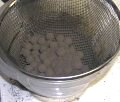
Sieve out the milling media

Dampen slightly
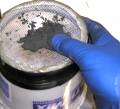
Press through a screen
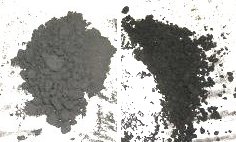
The stuff on the left is what comes out of the ball mill after 24 hours. It is a fine powder. The stuff on the right is the stuff on the left but wetted and pressed through a screen and dried. The stuff on the right is called pulverone. Note that it is considerably darker than the stuff on the left. Dampening makes it darker and also makes it more powerful.
If you want to make lift powder, you will need to use a wood that makes reactive charcoal. Soft woods and hard woods are designations for the carpenters, but for pyro, the terms get confused. Balsa and pine make great charcoal, but so do maple and willow. So 'soft' or 'hard' isn't a good category to use to determine if your charcoal will be reactive. The easiest suitable wood to get would be white pine or spruce - it is sold as construction lumber in 2 x 4 and smaller sizes. Be sure to get white pine (or spruce) - yellow pine doesn't work as good. Willow and maple are also very popular. You can get willow from a benevolent land owner (lots of luck). I ended up cruising the Missouri river back roads until I found a willow tree that was growing in the ditch. You can get maple at a lumber yard ($$$) or from a tree. After you ball mill the ingredients, moisten the powder so that it just clings together and press it through a screen (see the photos above).
Hydraulic Pressing and Corning. Corned powder is powder than has been broken into a grain after it has been pressed into blocks or pucks. Pressing powder makes it sturdier - it does not make it faster than an equivalent grain size in pulverone. Ok.. why does anyone press BP? A quote from Mike Swisher goes something like: "Uniform density makes volumetric measurement of a charge of uniform weight feasible. The main reason commercial powder is pressed to its typical density is to facilitate loading by volume." Another reason for pressing is that pressed powder is unlikely to crumble or separate with storage or vibration. For pyro uses, pressed powders aren't necessary but some love making great lift powder that has a sturdy grain - even though making it can be a lot of work. Others would just as soon use commercial powder or pulverone for their lift needs.
You can compress your BP using a hydraulic press so that it is at least 1.7 grams per cc. A simple pressing device is a reinforced 1.5" PVC tube with a suitable ram (you could pour one from Bondo). That will let you make enough pressed powder to see if you really want to do it. Go bigger if you like this sort of thing.
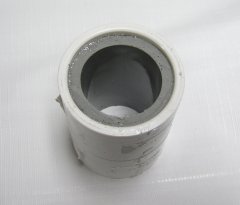
Basically, just make a large star pump (comet pump) and press out some very slightly dampened pucks that are compressed to 1.7 grams per cc (get out your math books and figure out the quantities needed). Dry thoroughly and break the pucks up with a baseball bat in a bucket and sift out the grains. The yield of any particular size grain (except dust) will be low. Dan Williams had a wonderful write up on the web about this but his site is down as of the writing of this paragraph - do a Google search for him - you might be able to find another site hosting his stuff.
If you really want to make your powder special, then glaze it with 1% graphite (put graphite and corned powder in a mill without media and tumble it for a while and sift out any dust). Glazing does not increase the speed - rather it decreases it a little. It makes the powder pour better and makes the grain less sensitive to static electricity. It also makes it look more pleasing.
Binders in Lieu of Corning. In the end, and if you don't want to mess with the hydraulic press stage, then use willow, maple or pine pulverone for lift powder - the results at charcoal_tests.html show that the pulverones are pretty powerful all by themselves. The problem is that they are weaker grains and tend to break down to the powder stage easily. When finely powdered, they are not as fast and they can separate over time so that they lose even more strength. You can add 3-5% dextrin (or 2 - 3% CMC or SGRS) to the pulverone before you ball mill it and it will toughen it up considerably. You can also use 3 - 5% gum arabic but you should dissolve it in boiling water before adding it to the BP. Adding a binder will also slow the pulverone down a bit - so everything's a trade-off, yanoe?
Interestingly, wettable garden sulfur has clay in it and it makes crunchier BP (sturdier BP) than pure sulfur does. Try some - you may not need to add binders to your BP if you use garden sulfur!
Agricultural Grade Chemicals. As we said at the front of this page - the main player in BP is charcoal. The following experiment was done using agricultural grade sulfur, stump remover and a good homemade charcoal. I believe the success of the experiment was due to the charcoal.
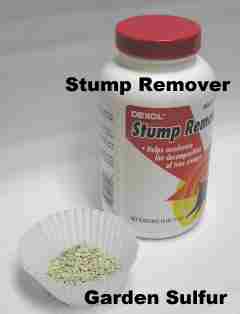
A sack of wettable sulfur (90% stuff) was purchased at a local garden shop. A pound of stump remover was purchased at a hardware store. After it was verified that the particular stump remover's main ingredient was potassium nitrate, each chemical was 'coffee ground' and then combined with airfloat white pine charcoal and milled - then pulverone was made from the mix. The result was delightfully surprising. The BP that was created from this setup was faster than the BP made from the same formula using commercial (Skylighter/Firefox) potassium nitrate/sulfur. It wasn't much faster - well within manufacturing tolerances - but it was very credible BP. Just two grams of it sent a 35 gram film can on a 7 second flight. The two wild card chemicals (sulfur and KNO3) were quite adequate when used with the relatively reactive white pine charcoal.
You can also get good KNO3 by purchasing bags of 15-0-44 (or similar) fertilizer. Sometimes, it comes in crystals such as seen below with the Haifa Multi-K brand. This type of fertilizer is used as a foliage spray and for tomatoes. The time to buy it is in the spring when the tomato growers are planting seedlings.
Black powder made with agricultural grade sulfur and the KNO3 shown below is technically inferior but, from a practical perspective, it is hard to distinguish it from BP made with much purer sulfur and KNO3. Again, it is the charcoal that makes the big difference. A paulownia charcoal BP was made with agricultural grade KNO3 and sulfur and the flight time for a 35 gram film can was 8.8 seconds. For comparison, Elephant brand 2fg (commercial sporting rifle BP) flight times average about 6 seconds.
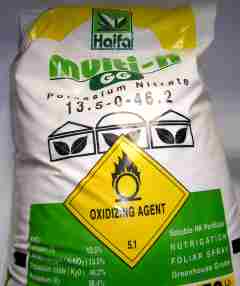
Haifa Multi-K KNO3 Fertilizer - another brand is Scott's Champion 13.5-0-44
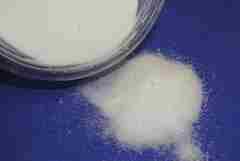
Haifa Multi-K Crystals
Cheap Tricks #1 Ok.. are you ready for this? To make perfectly acceptable BP
for most pyro uses (even lift powder if the mortar is over 2" or so), just mix
the three ingredients using a good charcoal like pine or willow - be sure the
charcoal and sulfur are airfloat! Wet the mix with hot water until it is
gravy. Mix thoroughly and then dry to mud and mix again. Mix one last time
when it is very thick and screen it. Dry thoroughly. The result will be a BP
that is comparable in speed to RPH.

Toss in sifted dry ingredients. The charcoal and sulfur MUST be airfloat!
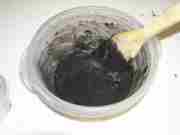
Mix with hot water until gravy
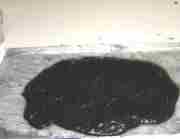
While drying, mix a couple of times until ready to screen

Screen twice. Dry to pulverone
A safety warning - black powder is powerful and just a gram or two can be lethal in the right circumstances. The picture below is the muzzle blast from a 2 gram charge in a 1.5" tube. Think of the damage if any part of your body contacts that jet of hot gases!
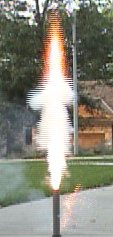
Make only the amount of powder you need - don't make and store large batches. Open up only the amount of powder you are likely to use. Keep the powder in a safe storage area. No one can afford an accidental ignition so play safe. Stay green.
Follow up data from a post on the Internet. This is somewhat redundant to the
above data but may be more concise:
We as a group have not agreed on the single definition of pulverone (nor even the spelling - it is sometimes spelled polverone) so it is always best to state it up front for the context.
A definition of pulverone for this site: Mill dust (using any ratio) that has been wetted and pushed through a screen and dried. Binders may be added but nothing else. This pulverone is also called riced BP by some - including me.
1. Mill dust won't necessarily be as fast as pulverone (riced BP). In most cases it isn't. The air in the grains of riced BP seems to aid in the flame propagation. This only works to a point - usually anything smaller than about 100 mesh is going to slow down - YMMV. Anything bigger than about 10 mesh is going to slow down - YMMV
2. Corned BP (BP that has been pressed to 1.7 grams/cc and then ground to desired mesh sizes) is almost never as fast as pulverone. The slick faces on the pressed BP grains tend to hold back flame propagation in comparison to the rough faces of the grains of pulverone. The reasons for corning are sturdiness and volumetric consistency. Corned BP can be measured by volume and get consistent weight - this makes it easier to use in rifles and cannon. Other benefits may include resistance to static discharges (if graphited) and better flow.
3. Adding anything to bind BP will slow it down. Obviously, you could add an explosive to it and claim otherwise but within the realm of binders, wheat flour, dextrin, SGRS, CMC, gum arabic, etc will all slow the BP down. The binder is added to make the pulverone grains harder - thus they stand up better during transportation, etc. I rarely add binders to my pulverone. I use garden sulfur and the clay in it seems to make the grains crunchy enough for me. YMMV
4. Wetting BP usually causes the nitrate to bind with the charcoal a bit better. Commercial manufacturers wet the BP and others have tested wetted vs unwetted and found wetted to be faster by several percentages. Alan Yates still has the results of his tests on his site (I think). OVER-WETTING will cause the nitrates to crystallize out and slow things down. Everything is a trade-off.